Ann Arbor City Council Sets Priorities
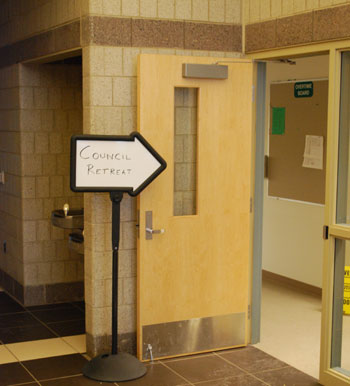
Once inside the Wheeler Service Center on Stone School Road, it was easy to find the city council retreat location.
At its budget retreat held on Saturday at the Wheeler Service Center, city council set out its priorities for the coming year: land use policy (i.e., zoning), economic sustainability, plus improved communication and service delivery.
This, after getting a picture of where the city stands from the city administrator, Roger Fraser, and his key staff: unless expenditures are reduced or else revenues increased, the city will experience a shortfall of revenue against expenditures starting in fiscal year 2010. Staff also outlined some significant projects that the public will start to see implemented or else be expected to help shape in the coming year. Those include increased use of web technologies (e.g., Facebook), more zoning revisions, possible dam removal, and regional coordination of safety services.
Fraser also offered conceptual drawings of a conference center that could be built on top of the proposed Fifth Avenue underground parking garage, and floated the idea of constructing a roof over Fourth Avenue for a bus station to replace the Blake Transit Center. The retreat took place in a workroom outfitted with one of 11 plasma screens that had recently caught the attention of an auditor, because they had been purchased in a manner inconsistent with city guidelines on credit card use.
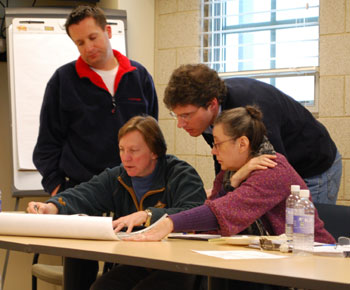
From left to right: Councilmembers Leigh Greden, Sandi Smith, Carsten Hohnke, Sabra Briere. They are looking at an aerial image of the Fourth Avenue section north of William Street, which city administrator Roger Fraser floated as a possible location for a Blake Transit Center replacement. The concept would be to leave the street open to traffic, but to build a roof over it.
The possible budget shortfalls were quantified as follows: shortfalls of $2.07 million in FY 2010 and $5.41 million on budgets of $87.02 million and $87.59 million, respectively. Key assumptions in these projections are that there will be a 1.25% reduction in tax revenues starting in 2010, followed by a reduction in 2011 by 5.2%. Projections also factor in a 2.5% increase in pension fund contributions for 2010, followed by a 36.6% increase in 2011.
The financial state of the city was characterized by Fraser as influenced by three key factors:
- The city’s property tax revenues are declining due to lower assessed values, Pfizer’s departure, and less new construction.
- Flat state shared revenue, with risk for decline.
- Investment losses in the pension fund may increase the city’s required future contribution.
The challenging picture painted by Fraser was reflected in priorities the council identified for the coming year. One of the top three was economic sustainability, which includes the exploration and thorough study of a city income tax and focus on an economic development strategy. Championing the study of the income tax question was councilmember Leigh Greden, though almost every time the words “city income tax” were spoken, John Hieftje, mayor of the city of Ann Arbor, stressed that he was not favorably inclined towards the idea.
Another priority was to finish what’s already been started in terms of rezoning and master planning of the city, partly because this was seen as related to the question of economic sustainability: One reason that property tax revenues are projected not to keep pace with expenditures is that there’s less activity on the new construction front. One of the initiatives in the area of land use and zoning expected to go forward in the coming year is the A2D2 process (zoning for downtown Ann Arbor). That project has been returned to the planning commission for possible revision in light of feedback from the public.
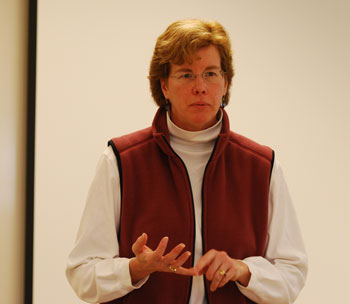
Jayne Miller, city of Ann Arbor director of community services, said the city was maximizing the proportion of the new combined parks millage dedicated to maintenance.
Improved communication and service delivery rounded out the top three priorities for council. Included in this focus is improved communication about service delivery. Councilmember Margie Teall reported that she was surprised (in a pleasant way) to discover the updates on snowplowing activity available over the web, as well as the availability of emailed updates on a range of topics. It was reported that over 7,000 people have registered for the email update service so far.
Communication was a theme that ran through much of the material presented by staff – in particular, communication in the form of web technologies. Jayne Miller, community services area director, indicated that parks and recreation programs would be exploring the use of social networking (like Facebook and Twitter) to help publicize their activities.
Sue McCormick, public services area director, advised councilmembers that online bill payment for utilities was expected to be available for the first quarter of 2009, along with a printed bill opt-out possibility. That is, if you’d like to pay your water bill online and never receive a printed bill in the mail, you’ll be able to do that. By the end of 2009, city residents might be able to get help from the city’s website using live chat.

Tom Crawford, chief financial officer for the city of Ann Arbor, said that five-year projections were difficult to make. He preferred to stick with 2-year forecasts.
The city’s data center, which serves the city’s web needs, is an example of another theme that ran through staff presentations: cooperation across different organizations. Tom Crawford, Ann Arbor’s chief financial officer, explained that the city’s data center would become a joint endeavor with Washtenaw County, which would help reduce capital investments when the center is moved into the new courts-police facility.
Further, there would an ongoing revenue stream from the county for utilities and rent of the data center. Among the other organizations the data center serves, Crawford mentioned the Ann Arbor District Library and the Ann Arbor Transportation Authority. With respect to the AATA, their web hosting up to now has been provided by IAS, which has been challenged recently by eviction from their offices. The switch to the city data center could be made as soon as Monday, Jan. 12, which could restore the mobile RideTrak system (real time bus information), which has been out of service since the IAS eviction.
Other examples of regional cooperation came from Barnett Jones, chief of safety services, who described a functional fire service district to be formed using Ann Arbor fire stations No. 4 and No. 6 with Ypsilanti’s fire station No. 1 to facilitate coordinated response on Ann Arbor’s east side. He also described talks with Pittsfield Township about combining stations. This idea was met with great skepticism from councilmember Marcia Higgins, in whose ward the change would be implemented. She cited the traffic from home football games as a challenge to be met by combining stations.
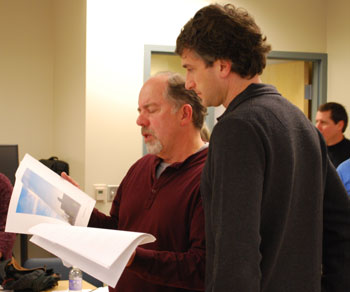
Left is city administrator Roger Fraser with city councilmember Christopher Taylor. They're looking at conceptual drawings for a possible conference center on top of the underground parking garage to be built at the library lot between Fifth and Division streets.
Traffic formed the basis of another example of cross-organizational cooperation: the north-south transit connector study, which is being funded jointly by the city of Ann Arbor, the Downtown Development Authority, the University of Michigan, and the Ann Arbor Transportation Authority. The proportion to be contributed by each partner is currently being hammered out, with Mayor Hieftje arguing for an increased share to be paid for by UM, because (i) the greater part of such a system’s benefit would go to UM, and (ii) the city of Ann Arbor and the DDA should be thought of as a single entity.
The AATA also came up in the context of Fraser’s announcement of two ideas he floated to councilmembers for their consideration, just before they broke into groups to thrash through their priorities for the year. The first of these ideas involved the AATA’s Blake Transit Center, located between Fourth and Fifth avenues, just north of the old YMCA lot. The BTC facility, Fraser said, needs either significant investment in its renovation or new construction. Fraser’s depiction is consistent with discussions on the AATA board’s planning and development committee, which is expecting an AATA staff presentation on the topic. From the minutes of its Dec. 16 meeting:
Dawn Gabay [interim executive director of AATA] reported that at the next committee meeting staff will make a presentation on possible renovations to the Blake Transit Center. Staff has been engaged in discussions with representatives from the City, the DDA, the Ann Arbor Library and the Ann Arbor Chamber of Commerce about redevelopment plans of the entire area surrounding the BTC.
The idea Fraser asked council to think about involved using the public right-of-way on Fourth Avenue, just north of William Street, as a new transit center. The street would remain open to traffic, but a roof would be constructed over the street. Jesse Bernstein, president of the Ann Arbor Area Chamber of Commerce and an AATA board member, was at the budget retreat on Saturday and offered his view that the current hub-and-spoke route system should be scrapped in favor of a spine-and-rib spine-and-nerve model. [The AATA recently conducted a study on the question, concluding that the hub-and-spoke model best served its mission.]
The second idea Fraser asked council to reflect on is one also associated by many community members with Bernstein: the idea of a downtown conference center. Holding a large manila envelope, Fraser said that he had conceptual drawings that had been developed by someone interested in seeing the parcel developed – it would sit on top of the proposed Fifth Avenue underground parking garage. He said he had permission from the proposer to show councilmembers the conceptual drawings. For The Chronicle, Fraser declined to identify the parties who had conveyed the drawings beyond saying that it was a developer in New York who had local ties. He said if the idea received traction on council, then the developer might be inclined to disseminate the drawings more widely.
Other key initiatives that Chronicle readers should expect to see take center stage in the coming months include public participation on the question of what should happen with Argo Dam, and public participation on the question of area, height, and placement zoning in the area outside the downtown.
Coda: Plasma Screens and P-Cards, Use of Public Funds
The budget retreat took place in a workroom at the Wheeler Service Center. The room was outfitted with a TV screen mounted in the corner of the room near the ceiling. [There's a photograph included in this story that depicts it.] No use was made of this technology during council’s retreat – councilmembers’ priority-setting task was completed using markers and large sheets of paper.

Ann Arbor City Council budget retreat. In corner of the room just below the ceiling is one of the plasma screens that was the subject of recent scrutiny by an auditor, followed up by Tom Crawford, the city's chief financial officer. The screens are used for information sharing at the beginning and ending of the work day, and to deliver training materials.
The screen, however, had received scrutiny earlier in the week by several councilmembers as part of their service on council’s audit committee. On Thursday evening, councilmembers Carsten Hohnke, Christopher Taylor, Stephen Rapundalo, Sabra Briere, and Mike Anglin, along with Roger Fraser, Sue McCormick, and Tom Crawford, met in the fifth floor conference room of the Larcom building for a supplemental committee meeting. The meeting focused exclusively on the topic of the purchase of 11 plasma screens for use at the Wheeler Service Center. Total cost for the screens was $16,252.98.
The purchase of seven of the screens had caught the attention of an outside auditor, because the three separate purchases had been made within minutes of each other using different city credit cards (P-cards). Each of the resulting three purchases was below $3,000, which is a threshold important for credit card use. The relevant city policies are outlined in a report on the audit from Crawford to councilmembers:
Purchasing policy #208 calls for the following:
- All purchases over $3,000 require the issuance of a purchase order and the approval of the Service Area Administrator.
- For “sole source” purchases, written documentation that a specified item cannot be obtained from any other source must be submitted.
- Purchases over $10,000 require living wage and civil rights certifications.
Credit card policy #512 calls for the following:
- Applicable requirements of policy #208 must be followed.
- Purchases must not be split to circumvent procurement procedures
Based on email correspondence, neither audit committee members nor other non-committee members of council were entirely content with the initial analysis and reaction by Crawford and staff. Rapundalo wrote:
I still am quite stunned by the overall incident and the temerity of those who violated known procedures, especially a new process that had just been instituted in the months leading up to the violation.
…
Furthermore, I believe that staff at the Wheeler Center should be apprised of the Audit Committee and Council’s concerns/actions over this procedural breach and insure their understanding of why screens are being relocated and privileges revoked.
The mood at Thursday’s audit committee meeting could fairly be described as somber. At that meeting, Rapundalo wanted to hear exactly how the city went from a building that was equipped with the wiring as a design specification, and constructed with such wiring, to a decision to purchase hardware. McCormick explained that decisions like these would typically be “discharged” to the staff.
Fraser gave the dimensions of the screens as ranging from 32 to 40 inches, “relatively small,” he said. This description was met with immediate objection from Briere and Rapundalo: “That’s not small!”
By the audit committee meeting’s conclusion, councilmembers seemed content that the matter had been adequately addressed. The key fact, for Rapundalo at least, seemed to be the revelation that a crucial piece of information had been miscommunicated: the funds used for purchase of the screens did not come from the Wheeler Service Center construction account, but rather from an operations account. Earlier, Crawford had mistakenly said that the funds had come from the Wheeler Center’s construction account.

Roger Fraser sorts through the priority lists delivered by councilmembers' three break-out groups. Goal: identify commonalities among the groups' top five priorities.
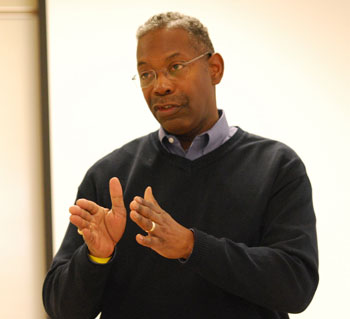
Safety services chief Barnett Jones included an update on crime over the last year: an uptick in larcenies, which he said was a national trend due to the poor economy. Factoid revealed at the meeting: Jones has delivered seven babies in the course of his career.
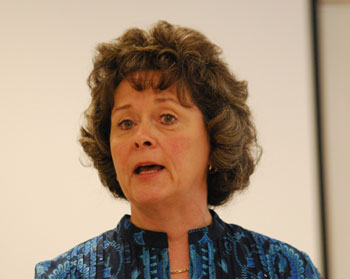
Sue McCormick, public services area director, talked about piloting "zonal" service delivery: a single crew dispatched to an area might be able to address multiple problems (tree trimming, pothole patching, sign maintenance).

Roger Fraser presented this slide, which was presented in 2002, with the final column, Phase IV, (highlighted with a cloud) corresponding to what is now the current time, 2009. It prompted lighthearted commentary from council to the effect that it's a good thing the city's new graffiti ordinance has not yet formally passed.





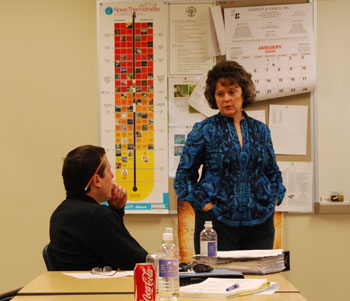

Where are the plasma screens being relocated, and whose privileges are being revoked?
Looks to me like the Hieftje-Greden-Rapundalo “Combo” are setting up the “good cop” “bad cop” scenario to try to muscle the University to pay more of their fair share of expenses by positing a City income tax that would hit U of M employees hard. Unfortunately it also hits our other employers. My opinion is the Combo knows there will not be much support by the voters for a City Tax. This is a tactic that can only make the relationship between Town and Gown deteriorate more. The Combo should drop the idle threats and start more dialogue with the University. We all know how well idle threats work with the U.
My view is that we should stop making idle threats and start making serious efforts to generate the Best Alternative to a Negotiated Agreement (BATNA) by creating a patient, well-organized petition drive to remove the property tax alternative.
link
If all those entities are discussing the future of the transit center, they have an opportunity now to consider some other possibilities, given that nothing is locked in yet with the library or the surface lot. I’d like to see them consider moving the transit center to the current library lot site in order to get all the buses off the street and so that the Greyhound station could be incorporated. Then a new library could be built on the current transit center and old Y sites. Finally, the current library could be razed and the site used for something else.
This is a golden opportunity to create a comprehensive transit center.
(Then if only we could get the post office to downsize and free up enough space to put some store fronts on Liberty, that area would really get hopping.)
How about putting the transit center by the Train Station?
With no further analysis than the top of my mind, I like where the transit center is now, and think the Greyhound station is in a poor location: why not move Greyhound to replace that stupid surface lot across from the library?
I’ve been to three retreats and this year’s format was almost identical to last year’s including many of the power point slides. Fraser always says there will be big deficits unless Council either cuts services or raises taxes or fees.
According to the audits, in 2008 the city had 19 million more in revenue than it did 5 years earlier and spent 15 million more than 5 years earlier. The increases have been adjusted for inflation. That means the city can afford to lose the $4 million in Pfizer revenue and still be ahead of where it was 5 years ago. It also means the city has not cut costs in real dollars despite all the service cuts. Maybe those flat screen TV’s are only the tip of the iceberg.
Despite the spending increase, city expenses for the past few years have failed to reflect the true cost of city benefits because the accounting rules did not require using realistic figures until 2008. That allowed the city to push the benefits problem down the road so what was a $90 million retiree health care problem in 2005 is now a $155 million problem. That increase is before considering the results of the financial meltdown.
The stock market meltdown has added to the problem but the rules allow the city to delay reflecting the market drop until 2011. The reason Crawford does not want to use 5 year projections is because it would reveal the huge financial hole the city is in. It’s hard to justify spending $47 million on a police/courts building and $56 million for a new parking structure for the proposed convention center when you will need to tell taxpayers that the benefits millage they pay no longer comes close to covering the cost of city retirement benefits.
Stew, the current transit center gets many downtown workers to within short walking distance of their place of employment. The train station is too far away and would require an additional trip to get them all downtown. As it is, AATA has set up a new route from the station to the transit center, which is a straight shot down 5th.
I emailed a request to city council members, asking them to consider the land swap possibility.
Karen, your apparent speculation about Crawford’s motives detracts from your otherwise objective (and valuable) analysis. I think you could convey the same information without mentioning Crawford.
Steve,
I agree on the short walk. I just thought that we could connect better with the trains if they ever arrive.
Stew
Steve,
Tom just sent me the 5 year projections, so they exist. Any projections involve speculation. On the expense side Tom showed Council longer term projections for the VEBA and pension plans. In my opinion those are the the two most speculative items in the expense projections. He also discussed with Council his assumptions for property tax revenues, which has the biggest impact on revenue projections. It would be a lot easier for Council to understand the implications of the financial and real estate meltdown to the city budget if they had seen the bottom line, or better yet, a range of bottom lines with optimistic to pessimistic assumptions for the next 5 years.
I don’t often name names, but I don’t think the city’s top management is off limits. My biggest complaint with the way business is done at the city is that the public does not get the complete and impartial information they need to provide meaningful input. The accounting scandals should have made everyone aware of how easy it is to manipulate financial information and get away with it. We only know about the ones that were caught. A few years ago I had a debate with a city employee (not top management) about a transaction that resulted in deducting the same expense twice. When I pressed, the answer I finally got was “I understand what you are saying but I have to do what I am told”
While I criticized Tom for not showing council the 5 year projections, he has also done positive things like take the initiative to clean up the billing mess in the utilities department. I also think the current auditor, which he helped select, is doing a good job.